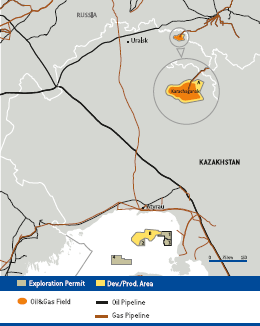Kazakhstan
Eni has been present in Kazakhstan since 1992. Eni co-operates the Karachaganak producing field and is a partner of the consortium of the North Caspian Sea PSA to develop the Kashagan field.
Kashagan
 Eni holds a 16.81% working interest in the North Caspian Sea Production Sharing Agreement (NCSPSA). The NCSPSA defines terms and conditions for the exploration and development of the Kashagan field which was discovered in the Northern section of the contractual area in the year 2000 over an undeveloped area extending for approximately 4,600 square kilometers. Management considered this field contains one of the biggest hydrocarbon resources discovered in 35 years. The NCSPSA will expire at the end of 2041.
Eni holds a 16.81% working interest in the North Caspian Sea Production Sharing Agreement (NCSPSA). The NCSPSA defines terms and conditions for the exploration and development of the Kashagan field which was discovered in the Northern section of the contractual area in the year 2000 over an undeveloped area extending for approximately 4,600 square kilometers. Management considered this field contains one of the biggest hydrocarbon resources discovered in 35 years. The NCSPSA will expire at the end of 2041.
The exploration and development activities of the Kashagan field and the other discoveries made in the contractual area are executed through an operating model which entails an increased role of the Kazakh partner and defines the international parties’ responsibilities in the execution of the subsequent development phases of the project. The North Caspian Operating Company (NCOC) BV, participated by the seven partners of the consortium has taken over the operatorship of the project. Subsequently development, drilling and production activities have been delegated by NCOC BV to the main partners of the Consortium: Eni has retained the responsibility for the development of Phase 1 of the project (the so-called “Experimental Program”) and, when sanctioned, the onshore part of Phase 2.
On September 11, 2013, following the completion, test and delivery of all infrastructures, the first oil from the giant Kashagan field was produced. From October 2013 production has been halted due to a technical issue that occurred to the pipeline transporting acid gas from offshore to onshore facilities, without any impact on the environment and local communities. Recovery activities are ongoing. Management believes that from 2015 field production will recover to the originally expected level.
The Phase 1 (Experimental Program) is targeting an initial production capacity of 150 kbbl/d; when the second treatment offshore train and compression facilities for gas reinjection will be completed and put online enabling to increase the production capacity up to 370 kbbl/d. The partners are planning to further increase available production capacity up to 450 kbbl/d by installing additional gas compression capacity for reinjection in the reservoir. The partners submitted the scheme of this additional phase to the relevant Kazakh Authorities.
In 2013 Eni submitted the development program of the Western section of the nearby Kalamkas discovery to the authorities. Sanction is expected in 2014 to start-up with the FEED phase.
Eni continues its commitment in the protection of the environment and ecosystems in the Caspian area with the integrated program for the management of biodiversity in the Ural Delta (Ural River Park Project - URPP). The project is almost completed and Eni’s aim to include it in the “Man and Biosphere Program” of UNESCO with positive consent of Kazakh Authority. Within the agreement signed with the relevant authorities, Eni continues its training program for Kazakh resources management positions.
Karachaganak
Located onshore in West Kazakhstan, Karachaganak (Eni’s interest 29,25%) is a liquid, gas and condensate giant field.
Operations are conducted by the Karachaganak Petroleum Operating Consortium (KPO) and are regulated by a PSA lasting 40 years, until 2037. Eni and British Gas are co-operators of the venture.
Production In 2013, production of the Karachaganak field amounted to 250 kbbl/d of liquids (61 net to Eni) and 865 mmcf/d of natural gas (214 net to Eni).
This field is developed by producing liquids (condensates and oil) from the deeper layers of the reservoir. The gas is marketed (about 50%) at the Russian terminal in Orenburg, re-injected in the higher layers and utilized for the production of fuel gas. Approximately 90% of liquid production are stabilized at the Karachaganak Processing Complex (KPC) with a capacity of approximately 250 kbbl/d and exported to Western markets through the Caspian Pipeline Consortium (Eni’s interest 2%) and the Atyrau-Samara pipeline which is linked to the Russian export network. The remaining volumes of non-stabilized liquid production (about 16 kbbl/d) and associated raw gas not re-injected in the reservoir are marketed at the Russian terminal in Orenburg.
Development The expansion project of the Karachaganak field is currently under study. The project is aimed for a further developing gas and condensates reserves by means of the installation, in stages, of gas treatment plants and re-injection facilities to support liquids production plateau and increase gas sales.
The development plan is currently in the phase of technical and marketing discussion to be presented to the relevant authorities, with FEED expected in 2014.
In 2013 Eni launched an environmental monitoring program to identify the best available monitoring operations for biodiversity protection. Eni continues its commitment to support local communities by means of the construction of schools and educational facilities as well as health assistance for the villages located in the nearby area of Karachaganak.
